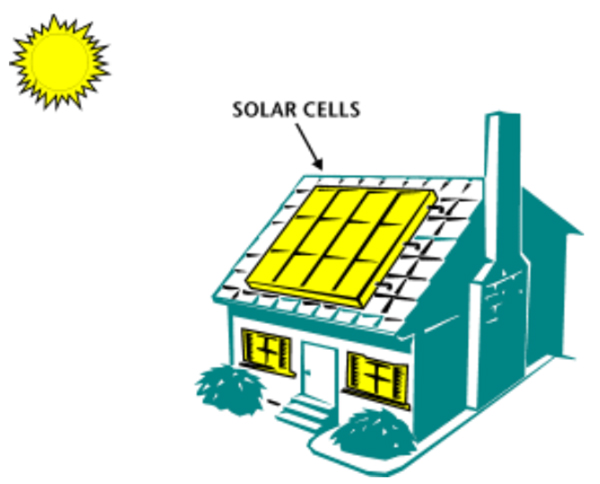Renewable Energy: Solar, Heat Thermal and Light Energy
The sun has produced energy for bilions of years. Solar energy is the sun's rays (solar radiation) that reach the earth. Solar energy can be converted into other forms of energy, such as heat and electricity. In the 1830s, the British astronomer John Herschel used a solar thermal collector box (a device that absorbs sunlight to collect heat) to cook food during an expedition to Africa. Today, people use the sun's energy for lots of things.
Solar energy can be converted to thermal (or heat) energy and used to:
- Heat water - for use in homes, buildings, or swimming pools.
- Heat spaces - inside greenhouses, homes, and other buildings.
Solar energy can be converted to electricity in two ways:
- Photovoltaic (PV devices) or "solar cells" - change sunlight directly into electricity. PV systems are often used in remote locations that are not connected to the electric grid. They are also used to power watches, calculators, and lighted road signs.
- Solar Power Plants - indirectly generate electricity when the heat from solar thermal collectors is used to heat a fluid which produces steam that is used to power generator. Out of the 15 known solar electric generating units operating in the United States at the end of 2006, 10 of these are in California, and 5 in Arizona. No statistics are being collected on solar plants that produce less than 1 megawatt of electricity, so there may be smaller solar plants in a number of other states.
Photovoltaic energy
Photovoltaic energy is the conversion of
sunlight into electricity. A photovoltaic cell, commonly called a solar cell or
PV, is the technology used to convert solar energy directly into electrical
power. A photovoltaic cell is a nonmechanical device usually made from silicon
alloys.
Sunlight is composed of photons, or particles
of solar power renewable energy. These photons contain various amounts of
energy corresponding
to the different wavelengths of the solar spectrum.
When photons strike a photovoltaic cell,
they may be reflected, pass right through, or be absorbed. Only the absorbed
photons provide energy to generate electricity. When enough sunlight (energy)
is absorbed by the material (a semiconductor), electrons are dislodged from the
material's atoms. Special treatment of the material surface during manufacturing
makes the front surface of the cell more receptive to free electrons, so the
electrons naturally migrate to the surface.

The photovoltaic cell is the basic building block of a photovoltaic system. Individual cells can vary in size from about 1 centimeter (1/2 inch) to about 10 centimeter (4 inches) across. However, one cell only produces 1 or 2 watts, which isn't enough power for most applications. To increase power output, cells are electrically connected into a packaged weather-tight module. Modules can be further connected to form an array. The term array refers to the entire generating plant, whether it is made up of one or several thousand modules.
The number of modules connected together in an array depends on the amount of power output needed. The performance of a photovoltaic array is dependent upon sunlight. Climate conditions (such as clouds, fog) have a significant effect on the amount of solar energy received by a photovoltaic array and, in turn, its performance. Most current technology photovoltaic modules are about 10 percent efficient in converting sunlight. Further research is being conducted to raise this efficiency to 20 percent.
The photovoltaic cell was discovered in 1954 by Bell Telephone researchers examining the sensitivity of a properly prepared silicon wafer to sunlight. Beginning in the late 1950s, photovoltaic cells were used to power U.S. space satellites (learn more about the history of photovaltaic cells). The success of PV in space generated commercial applications for this technology. The simplest photovoltaic systems power many of the small calculators and wrist watches used every day. More complicated solar electric power generation provide electricity to pump water, power communications equipment, and even provide electricity to our homes.
Some advantages of photovoltaic systems are:
- Conversion from sunlight to electricity is direct, so that bulky mechanical generator systems are unnecessary.
- PV arrays can be installed quickly and in any size required or allowed.
- The environmental impact is minimal, requiring no water for system cooling and generating no by-products.
- Photovoltaic cells, like batteries, generate direct current (DC) which is generally used for small loads (electronic equipment). When DC from a photovoltaic solar cell is used for commercial applications or sold to electric utilities using the electric grid, it must be converted to alternating current (AC) using inverters, solid state devices that convert DC power to AC.
Solar thermal heat
Solar thermal (heat) energy is often used
for heating swimming pools, heating water used in homes, and space heating of buildings.
Solar space heating systems can be classified as passive or active.

Passive space heating is what happens to your car on a hot summer day. In buildings, the air is circulated past a solar heat surface(s) and through the building by convection (for example, less dense warm air tends to rise while more dense cooler air moves downward). No mechanical equipment is needed for passive solar heating.
- Active heating systems require a collector to absorb and collect solar radiation. Fans or pumps are used to circulate the heated air or heat absorbing fluid. Active systems often include some type of energy storage system.
- Nonconcentrating collectors – have a collector area (for example, the area that intercepts the solar radiation) that is the same as the absorber area (for example, the area absorbing the radiation). Flat-plate collectors are the most common and are used when temperatures below about 200o degrees F are sufficient, such as for space heating.
- Concentrating collectors – where the area intercepting the solar radiation is greater, sometimes hundreds of times greater, than the absorber area.
Related blog posts: